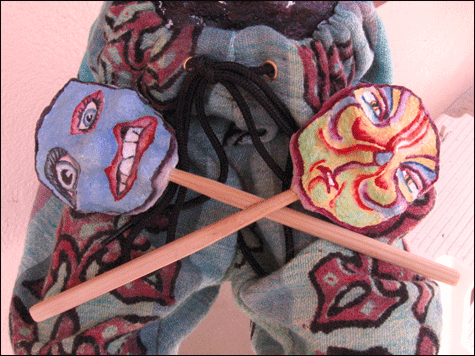When local mixed-media artists Martha Miller and Alex Rheault hatched an idea six months ago to collaborate with multiple artists in a serious game of Exquisite Corpse-meets-chain letters, they had no idea the effort would lead to the overwhelming amount of material displayed at “Metamorphosis: A Journey of Dolls,” exhibiting now at drawing room, Rheault’s space at 142 High Street.They also didn’t know that personal beliefs and interpersonal dynamics would produce both deep conflict and intense conversation as the project progressed. Sixteen other artists joined them to work on “dolls.” These sculptural entities, ranging in appearance from figures reminiscent of traditional dolls to veritable Frankenstein’s monsters, were evolved by artists individually, each having a month to construct body parts, decorate with paints and clothing, or restructure the whole piece altogether, before sending it through the mail to the next person on the list.
As the dolls changed hands, so did accompanying journals, in which the artists wrote about what they saw, what they thought, what they did, and how they felt. They often documented their work with photographs of the dolls’ “development.” Participants could then see what other members had accomplished; an unexpected outpouring of heated debate among the groups ensued, concerning what can and can’t be done with other individuals’ contributions to the whole. Discussion maintained a boiling point, fueled by participants’ remembrances of childhood and sensitivities to issues of race and gender. Suddenly, everyone was more involved than they initially expected.

For the viewer, there’s an overabundance of material. The dolls on display are unlike any dolls you’ve ever seen: some are elaborate shrines with figures surrounded by baubles or adorned with text, while others abandon human form altogether with limbs protruding from furry bodies. You can look at a large stuffed bird hanging from the ceiling, its wooden talons clutching a bulbous, sack-like organ with both male and female genitalia, and ask yourself, “how did a doll turn into this?”
Part of the answer lies in the photos, and part in the journal entries. It turns out that bird never started as a figure, but a mass of felt shapes, a bizarre headdress sewn together like seaweed. It continued to evolve until the bird shape was stuffed with the original material, leaving only the bird’s cargo to represent the original intention. You can, in a sense, cross-reference the development of the piece by consulting a large tome, compiled and beautifully hand-bound by Anastasia Weigle, containing all the e-mail correspondence among the participants. In this interactive manner, you graduate from a voyeuristic role to a sense of participation in an ongoing project.
The process-oriented undertaking of “Metamorphosis” is a good fit for Portland’s self-questioning creative community, which is always looking for more interchange. Although many of the completed dolls on display are aesthetically intriguing, able to stand on their own as pieces rooted in craft and transformed by artistic impulse, the value of the exhibit comes from your experience of poring through the multi-faceted results. If those results aren’t compelling for you personally, you can still draw in what happened when this group began interacting and that there is no end in sight of that interaction’s transformative effects. If for no other reason, go to this show for inspiration in setting up your own homegrown systems of creative activity and collaboration.
 |
CUSTODIANS OF COLLABORATION
A talk with co-curators Alex Rheault and Martha Miller:
Alex, you’ve described drawing room as having a social and literal function, expanding the notions of drawing. How does the “Metamorphosis” project fit into this mission? How did it get started?
ALEX RHEAULT This project brought together eighteen women, many of whom would not have agreed to work together under other circumstances, or were too far apart, physically or artistically. We were brought together, willing to have a dialogue about something we knew little about. The gamut of emotions and responses to the process reflects the diversity and variety that this space is about.MARTHA MILLER The process came from a book called The Doll Chronicles, but when I tried this before, the rules were a little different. With this project, right away, there was a conversation: “do we simply add to this doll, do we have to follow the lead of the person before us?” or: “do we own that doll when we have it and not have to consider the work of the person before us in a way that would limit our decisions?”
Unlike a simple game of Exquisite Corpse, where you unfold the paper and everyone laughs, there’s an exploration of personal depths. Is that what you all set out to do?
MM We didn’t realize the can of worms we were opening. Problems starting popping up as we moved along. Not having clear boundaries from the beginning is also part of what makes it exciting, though. It’s like raising a child. You don’t have control. We let our children go into the world. The dolls were a similar process of acceptance.